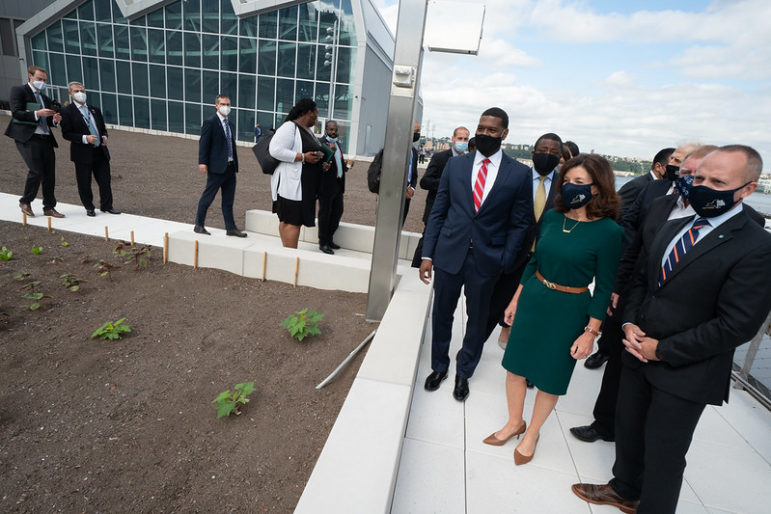The initiatives come just over two weeks after the remnants of Hurricane Ida caused flash-flooding that killed over a dozen New Yorkers and after a summer of multiple record-breaking heat waves.

Gov. Kathy Hochul’s Office
Gov. Kathy Hochul with EPA Administrator Michael Regan during a Climate Week announcement.During New York City’s annual Climate Week, local and state legislators served up a litany of environmental policy announcements to improve infrastructure, invest in clean energy and promote climate justice.
These initiatives come just over two weeks after the remnants of Hurricane Ida caused flash-flooding that killed over a dozen New Yorkers and after a summer of multiple record-breaking heat waves.
Following are some of the highlights from the week, culminating in a report released Monday by Mayor Bill de Blasio on how the city to better prepare for extreme weather:
Green light on green energy
On the first day of Climate Week, Gov. Kathy Hochul announced she had approved two proposals to bring wind, solar and hydropower to New York. The projects are two of seven submitted in response to the New York State Energy Research and Development Authority’s (NYSERDA’s) January request for proposals. Combined, they would bring enough renewable energy to heat 2.5 million homes in the state.
Hochul also directed NYSERDA to create a roadmap this fall outlining how the state can reach a goal of 10 gigawatts of solar energy by 2030 (the state is almost at its current goal of six gigawatts by 2025).
Hochul said she’d also invest $36 million in the creation of “regional green energy hubs” to help improve community engagement in climate-focused efforts — particularly in disadvantaged communities.
And the governor said she’d allocate $59 million to the Clean Green Schools initiative, which will launch next year and strive to improve indoor air quality and energy efficiency in public and private schools.
Focus on environmental justice
Hochul announced last week that under her direction, the Department of Environmental Conservation will conduct hyperlocal air monitoring in 10 areas around the state, with a focus on disadvantaged communities. The effort will measure levels of pollutants and greenhouse gas emissions.
Communities of color, including the South Bronx and areas of Queens, have historically high asthma rates and are overburdened with highways, waste transfer facilities and power plants, all of which contribute to poor air quality and detrimental health effects for the residents.
“For generations, black, brown, and low-income communities have been the reluctant hosts of polluting infrastructure and toxic emissions from fossil fuel plants, highways, solid waste, and diesel trucks to name a few, creating a legacy of historic health disparities,” said Elizabeth Yeampierre, director of the Sunset Park–based group UPROSE, in a press release. Earlier this summer, Yeampierre met with Secretary of Energy Jennifer Granholm and expressed the need for local, community involvement in creating solutions to the climate crisis.
Investing in infrastructure and resiliency
The governor also announced she was allotting $600 million in grants to invest in infrastructure that would make communities statewide more resilient to storms and flooding, and proposed an additional $1 billion — for a total of $4 billion — for Environmental Bond Act, which would finance projects to improve resiliency infrastructure, water quality, conservation and climate change mitigation.
The act, which was set to be considered by voters in November 2020, was pulled from the ballot by the Cuomo administration. It will instead be considered by voters next fall. Gov. Hochul also said she would rename the act the “Clean Water, Clean Air and Green Jobs Environmental Bond Act.”
“Increased funding for clean water infrastructure and the Environmental Bond Act – including critical nature-based solutions like restoring and enhancing wetlands and salt marshes – will provide direct support to communities that are experiencing the impacts of climate change,” said Erin McGrath of Audubon New York in a statement.
Other legislators also used the week to push forth agendas related to storm resiliency.
In a Coney Island press conference on Friday, mayoral candidate and Brooklyn Borough President Eric Adams pledged to, if elected, implement a resiliency plan for the city that includes an early warning system with sirens, an effort to bring basement apartments up to code and the appointment of a climate czar.
“Mother Nature’s not going to wait for us to build out a 20-year plan,” he said.
And on Monday, Mayor Bill de Blasio released a report outlining the city’s plan to prepare for and respond to extreme weather. The plan calls to appoint an extreme weather coordinator in City Hall, create a “Rainboots on the Ground” program to conduct outreach in disadvantaged communities and make upgrades to the city’s sewage and drainage systems.
De Blasio also said he’s investing $2.1 billion in funding for the Department of Environmental Protection, and another $500,000 toward the Parks Department, Department of Transportation and other agencies.
“We will plan for the worst-case scenario in every instance,” the report says.
Liz Donovan is a Report for America corps member.










One thought on “ICYMI: Announcements and Investments During NY’s Climate Week”
Investments in alternative energy must be communicated to and approved by the government. It’s time to think about ecology and the consequences of constant atmospheric pollution. Solar energy is our future.